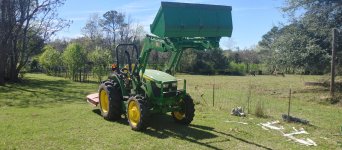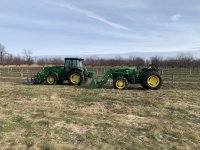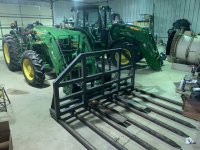Mo1 seems to have a better grasp on what a 5E is than most on the internet. First "E" doesn't stand for "economy" in the JD lineup of tractors. Nowhere has JD (I'm not talking about some stupid JD salesman working at any given dealership who's subscribed to the "E for economy" narrative found on internets) ever made the claim that they put an E in their models name to stand for economy. This was invented by people on forums like this speaking on the internet claiming E for economy. With that said we do understand that the E series in the JD lineup signifies more of their base/entry level models that give you fewer frills for fewer dollars. Hey maybe E stands for entry level machine.?.?.? Or maybe E just precedes M, which precedes R, like D precedes E, and the older D models were more entry level than the E's. Or maybe E does stand for economy, and M stands for middle tractor, and R for rich people tractor.?.?
But really the 5E doesn't need to be viewed as an entry level machine compared to an M or R. These are different class machines. The 5E gives you most of the niceties and comforts to get the job done minus fender mounted 3PH controls and maybe a buddy seat or something. Probably no cab suspension, and the rearview camera mirror, HUD, and heated/vented/massaging seats found in your C8 Corvette are missing, but you get heat, A/C, radio, etc, and in 23 they allow for a premium cab option.
What I'm getting at is that the main value you're getting in a 5M over a 5E is the M is a larger, and more capable machine. Sure the 5M and especially the 5R will give you an amenity or 2 that the 5E neglects, but overall a cabbed 5E gives you everything to working in a comfortable, cool, (or warm) relatively quite, flat, spacious environment, while you jam to your music or listen to your favorite podcast, with you seat and steeringwheel adjusted to your desired positions. People who claim that, "a Kubota M60 series is a premium tractor, and a JD 5E is an economy tractor, and hence they shouldn't be compared, and that to find a JD that's actually comparable to a M60 series tractor you have to step up to a 5M or even a 5R, but that's a bad comparison because of the cost difference" and either stupid, lying, or ignorant. More than any other tractor on this planet a M60 series is trying to compete and out do a 5E series, and vica versa. It's just like Silverado 1500 vs. F150. For example when you look at a 5075E vs
M7060 everything other than their overall weights are extremely close between the two. Their wheelbases, tires, transmissions, features and amenities, options, 3PH/FEL capabilities, MSRP's are very comparable and close to one another. A 5075M is rated to lift noticeably more weight, noticeably higher at the FEL, and 1,400-2,500 lbs (depending on what 5M 3PH option you choose) at the 3PH than either a 5075E or
M7060. A 75M has about a 8" longer wheelbase than a M60 and 10" longer than a 5E 3 cylinder. A 5075M weights a ton more than a
M7060 or 5075E. (literally it's rated at 2,200-2,300 lbs more than a
M7060 and 1,600-1,700 lbs more than a 5075E when comparing the same operator station configuration) The 5M's most base transmission is better than a
M7060 or 5075E's best transmission options. It's tire options go much larger than the 7060 or 75E as does it's fuel capacity. Just the physical size of a 5M is noticeably bigger than either a
M7060 or 5075E, so no a 5075M is not a
M7060's true competitor, which a 5075E is. It's the same thing with a MF 4707. These dealers on YT want to always compare machines from their brands to other brands at obvious disadvantages and not apple to apple comparisons. MF dealers like to compare a 5075E or
M7060 to a 4707. Not necessarily intended competitors. A 2607H is more then intended competitor for the
M7060/5075E. A 4707 is a noticeably larger tractor than a
M7060 or 5075E, but when I tell them to compare a 4707 to a 5075M they don't want to do that because a 4707 falls inbetween a 5075E and 5075M in terms of size, capabilities, amenities, price, and a transmission option on a 5E's level. They just respond, "well I'm basing this comparison off the price," and I respond with, not a MSRP, but possibly any given dealers markup price." They are all competitors in the sense that they are all AG/utility based tractors, in the 75 HP range. Still there are levels to this. For example you can get a F150 with similar HP to a F350, but when you look at both trucks work specs the F350 blows the F150 out the water in payload and towing ratings. But it should as it's a noticeably larger, and more expensive machine. Still a larger and more capable/expensive machine isn't always desirable. In some cases you want a smaller, more nimble, easier to deal with tractor. Then there are times you wish you had a larger, more capable, heavier tractor to manage more work, more effectively, efficiently, and safely. A 5E, M60, 2600H fill a much more traditional role than the 5M, 4700 series from MF, etc. The 5M and 4700 series are sort of in a class by themselves that JD and MF created, even though traditionally speaking tractors in their HP range could be in their size range as well. Still the 5E/M60/2600H fill the roles that machines from the past like a JD 2240 or 2155 filled, or a Ford Powermaster 861D, 3910, 3930, 4630, 2000/3000/4000, 2600/3600, etc, or a MF 165, 245, 255, 270, 290, etc, or a International 484/584, or a CIH 485/585/685, etc, etc, filled. They are small enough to be easy to use for most things without being inconvenient, but large enough and powerful enough to be capable of pulling a hat off your head unlike maybe a 8N or Farmall Cub. These tractors work well at everything from bush hogging, to being a plow horse for someone who's primary occupation isn't farming, to getting you in and out the woods to cut firewood, to being a capable loader machine, to grass farming, to working with your livestock, to being not too cumbersome to needing a truck requiring a CDL to transport. These machines fill a very old and important niche. Your typical compact tractor owner is looking to fill a different role than someone who considers these machines. You're not going to want to use a compact tractor to manage a large round baler, a heavy disc mower. You're probably also not going to want to use a compact tractor to pull an 8' disk to plow up food plots in a wet swamp, or maybe use to farm some small acreage as a secondary farming, hobby type job. Then there are roles that a compact or larger utility or row crop machines fill better than a 50-80 HP, 2-2.5 ton Ag style utility tractor fills.


